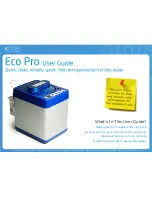
Important Safety Information
Any hazard from reaction with other substances
How to clean/dispose of spillage
Appropriate protective measures
Appropriate storage and handling
Although these regulations may not be applicable in your country, it is strongly
recommended that a similar approach be adopted for the protection of the students
operating the equipment. Local regulations must also be considered.
Water Borne Hazards
The equipment described in this instruction manual involves the use of water, which
under certain conditions can create a health hazard due to infection by harmful
micro-organisms.
For example, the microscopic bacterium called Legionella pneumophila will feed on
any scale, rust, algae or sludge in water and will breed rapidly if the temperature of
water is between 20 and 45°C. Any water containing this bacterium which is sprayed
or splashed creating air-borne droplets can produce a form of pneumonia called
Legionnaires Disease which is potentially fatal.
Legionella is not the only harmful micro-organism which can infect water, but it
serves as a useful example of the need for cleanliness.
Under the COSHH regulations, the following precautions must be observed:
Any water contained within the product must not be allowed to stagnate, ie.
the water must be changed regularly.
Any rust, sludge, scale or algae on which micro-organisms can feed must be
removed regularly, i.e. the equipment must be cleaned regularly.
Where practicable the water should be maintained at a temperature below
20°C. If this is not practicable then the water should be disinfected if it is safe
and appropriate to do so. Note that other hazards may exist in the handling of
biocides used to disinfect the water.
A scheme should be prepared for preventing or controlling the risk
incorporating all of the actions listed above.
Further details on preventing infection are contained in the publication “The Control
of Legionellosis including Legionnaires Disease” - Health and Safety Series booklet
HS (G) 70.
Electrical Safety
The equipment described in this Instruction Manual operates from a mains voltage
electrical supply. It must be connected to a supply of the same frequency and voltage
as marked on the equipment or the mains lead. If in doubt, consult a qualified
electrician or contact Armfield.
The equipment must not be operated with any of the panels removed.
To give increased operator protection, the unit incorporates a Residual Current
Device (RCD), alternatively called an Earth Leakage Circuit Breaker, as an integral
15
Содержание UOP4 MKII
Страница 1: ...SOLID LIQUID EXTRACTION UNIT Instruction Manual UOP4 MKII ISSUE 16 November 2010...
Страница 4: ......
Страница 7: ...Equipment Diagrams Figure 1 Front View of UOP4 MKII Solid Liquid Extraction Unit 3...
Страница 8: ...Armfield Instruction Manual Figure 2 Side View of UOP4 MKII Solid Liquid Extraction Unit 4...
Страница 9: ...Equipment Diagrams Figure 3 UOP4 MKII Schematic Diagram Showing 3 Stage Process 5...
Страница 10: ...Armfield Instruction Manual Figure 4 UOP4 MkII Console Front View 6...
Страница 11: ...Equipment Diagrams Figure 5 UOP4 MkII Console Rear View 7...
Страница 12: ...Armfield Instruction Manual Figure 6 PCB Connections 8...

































